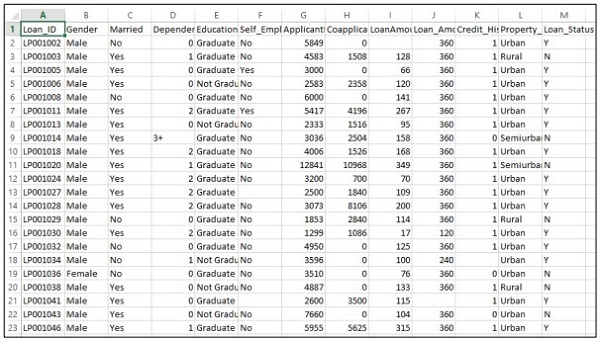В этой главе мы сосредоточимся на исправлении проблемы прогнозирования с помощью определенного сценария.
Учтите, что компания хочет автоматизировать данные о предоставлении кредита в соответствии с данными клиента, предоставленными через онлайн-заявку. Данные включают в себя имя клиента, пол, семейное положение, сумму кредита и другие обязательные данные.
Детали записываются в файл CSV, как показано ниже —
Выполните следующий код, чтобы оценить проблему прогнозирования —
import pandas as pd
from sklearn import ensemble
import numpy as np
from scipy.stats import mode
from sklearn import preprocessing,model_selection
from sklearn.linear_model import LogisticRegression
from sklearn.preprocessing import LabelEncoder
#loading the dataset
data=pd.read_csv('train.csv',index_col='Loan_ID')
def num_missing(x):
return sum(x.isnull())
#imputing the the missing values from the data
data['Gender'].fillna(mode(list(data['Gender'])).mode[0], inplace=True)
data['Married'].fillna(mode(list(data['Married'])).mode[0], inplace=True)
data['Self_Employed'].fillna(mode(list(data['Self_Employed'])).mode[0], inplace=True)
# print (data.apply(num_missing, axis=0))
# #imputing mean for the missing value
data['LoanAmount'].fillna(data['LoanAmount'].mean(), inplace=True)
mapping={'0':0,'1':1,'2':2,'3+':3}
data = data.replace({'Dependents':mapping})
data['Dependents'].fillna(data['Dependents'].mean(), inplace=True)
data['Loan_Amount_Term'].fillna(method='ffill',inplace=True)
data['Credit_History'].fillna(method='ffill',inplace=True)
print (data.apply(num_missing,axis=0))
#converting the cateogorical data to numbers using the label encoder
var_mod = ['Gender','Married','Education','Self_Employed','Property_Area','Loan_Status']
le = LabelEncoder()
for i in var_mod:
le.fit(list(data[i].values))
data[i] = le.transform(list(data[i]))
#Train test split
x=['Gender','Married','Education','Self_Employed','Property_Area','LoanAmount', 'Loan_Amount_Term','Credit_History','Dependents']
y=['Loan_Status']
print(data[x])
X_train,X_test,y_train,y_test=model_selection.train_test_split(data[x],data[y], test_size=0.2)
#
# #Random forest classifier
# clf=ensemble.RandomForestClassifier(n_estimators=100,
criterion='gini',max_depth=3,max_features='auto',n_jobs=-1)
clf=ensemble.RandomForestClassifier(n_estimators=200,max_features=3,min_samples
_split=5,oob_score=True,n_jobs=-1,criterion='entropy')
clf.fit(X_train,y_train)
accuracy=clf.score(X_test,y_test)
print(accuracy)
Выход
Приведенный выше код генерирует следующий вывод.
